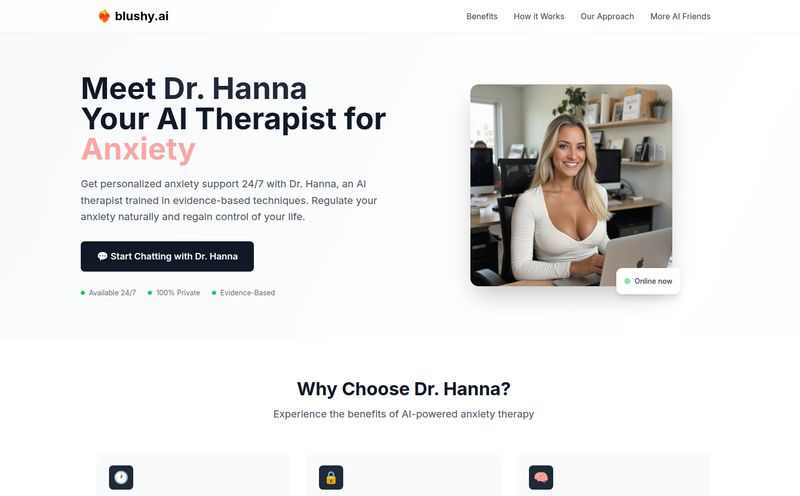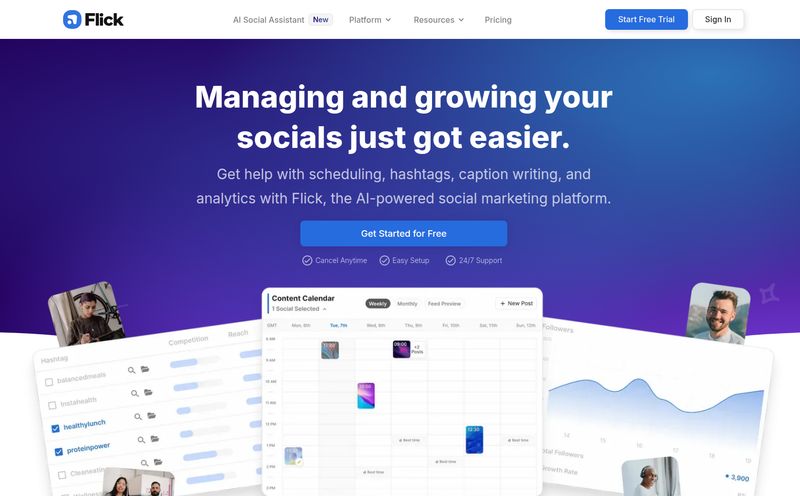I’ve been in the SEO and traffic game for a long time. I’ve seen trends come and go faster than you can say “algorithm update.” From the rise of the blog, to the dominance of video, to the absolute chaos of TikTok. But every now and then, something pops up on my radar that makes me stop and just... stare. Something that feels less like an iteration and more like a hard left turn into the future.
That’s the feeling I got when I landed on the MixPix AI homepage. It's stark, almost comically simple. A dark background, a logo, and a single, bold promise: “Easily Generate Photos with AI models for FREE!”
My first thought? Okay, another AI image generator. Cool, but not exactly groundbreaking in a post-DALL-E world. But I was wrong. The hook isn't just about generating images; it's about generating images with AI influencers. It’s about fan interaction. And that, my friends, is a whole different ball game.
So, What is MixPix AI, Really?
Let's break it down. MixPix AI isn't trying to be the next Midjourney, where you conjure up fantasy landscapes or photorealistic cats in astronaut suits. Instead, it’s positioning itself as a bridge. A strange, digital bridge between a fan and their... well, their favorite AI model or influencer. The core idea is to give you, the follower, the power to create a personalized photo experience. A virtual selfie, if you will.
Think about it. For years, the pinnacle of fan interaction was a blurry photo at a convention, a signed headshot, or maybe a pricey 30-second video from Cameo. MixPix AI is proposing a new kind of currency for fan engagement. One where you don’t just consume an influencer’s content, you insert yourself directly into it. It’s a wild idea. But is it a good one? I’ve been kicking this around in my head for a bit, and I’m still not entirely sure.

Visit MixPix AI
How Does This Thing Actually Work?
Based on the minimalist landing page, the user flow seems pretty straightforward. You see a big blue “Sign in - Google” button, which tells me they’re going for a low-friction entry point. No complicated sign-up forms, just a quick OAuth and you're in.
From there, I imagine the process looks something like this:
- Choose Your AI Model: You'll probably be presented with a gallery of available AI influencers or models that the platform hosts.
- Set the Scene: This is where the magic (and the prompting) happens. You’d describe the scenario. “Me and AI influencer 'Nova' having coffee in a Parisian café,” or “A picture of me hiking a mountain trail with 'Jax' at sunset.”
- Upload Your Photo (Maybe?): This is the big question. To put you in the photo, the AI would likely need a source image. This could be a simple face upload or a full-body shot. This part has massive implications for how good the final output is.
- Generate and Tweak: Hit the button and watch the AI do its thing, blending your likeness with the AI model in the scene you described. I'd expect some options for regeneration if the first one comes out with teh classic AI-generated six-fingered hands.
It sounds simple enough, but the tech to do this convincingly is incredibly complex. Getting lighting, perspective, and style to match between a user-uploaded photo and a generated scene? That's no small feat.
The Big Idea: Personalized Parasocial Relationships
Okay, let's get into the meat of it. Why does this even matter? The term that keeps coming to mind is “parasocial relationship.” It’s the one-sided connection we feel with figures we see in the media. For decades, marketers have tried to make these relationships feel more real, more personal. MixPix AI is like pouring gasoline on that fire. It's offering to create a tangible, visual artifact of that relationship, even if the relationship is with a person who doesn't technically exist.
A New Frontier for Engagement and UGC
From a marketing perspective, the potential is... staggering. Imagine a brand creating its own AI mascot or influencer. Instead of just pushing content, they could invite users to create photos with their mascot. This turns passive consumption into active participation. It’s a new breed of User-Generated Content (UGC) that’s perfectly on-brand every single time. The memes would create themselves. The brand recall would be off the charts.
For human influencers, this opens a weird but fascinating door. They could license their likeness to create an AI version of themselves, allowing them to offer these personalized photo ops at a scale that's physically impossible. It's a way to monetize their brand without spending more time at meet-and-greets.
But What About The Authenticity Question?
And here’s the rub. The big, glaring issue that we can’t ignore. The “con” in this whole equation is the complete and total lack of authenticity. It’s not a real memory. It's a generated fantasy. Some people will find this creepy or just plain sad. I get it. There's a part of me that feels the same way.
But then another part of me, the part that’s watched social media evolve for years, has to ask: how “real” is a heavily filtered, perfectly posed, brand-sponsored Instagram post anyway? We’ve been curating and fabricating our digital realities for over a decade. Is this really so different? Maybe it’s just more honest about its own fakeness. It’s not pretending to be a candid moment; its entire premise is that it's a beautifully crafted fabrication. I've always felt that transparency is key in marketing, and in a weird way, this is radically transparent.
Let's Talk About the Price Tag
The homepage screams “FOR FREE!” in all caps. As anyone in this business knows, “free” is never really free. So what's the business model? There are a few possibilities:
- A Freemium Model: The basic service is free, but you pay for higher resolution images, more generation credits, premium AI models, or advanced features. This is the classic SaaS playbook.
- Data & Training: Your prompts and the images you create are valuable data for training better AI models. You're “paying” with your creativity.
- Beta Phase: It could just be free while they’re in beta, gathering feedback and building a user base before flipping the monetization switch. My money is on a combination of all three.
For now, though, the barrier to entry is zero, which is smart. It encourages experimentation and gets the tool into as many hands as possible, letting viral word-of-mouth do the heavy lifting.
My Honest Take on MixPix AI
Frankly, I'm torn. On one hand, MixPix AI feels like a glimpse into a very strange, very niche future of digital interaction. It’s like Cameo and Midjourney had a weird, futuristic baby. The potential for creative marketing campaigns and a new form of fan engagement is undeniable. It's a tool that understands the creator economy's deep-seated need for personal connection at scale.
On the other hand, it raises some thorny questions about what we value in our interactions. Are we heading toward a future where our most cherished photo memories are with people who don't exist? It's a bit dystopian. But I'm also a pragmatist. The tech is here, and it's not going away. People will use this. The challenge for us as marketers and creators is to find ways to use it that are fun, engaging, and maybe, just maybe, a little bit self-aware.
At the end of the day, it's a new tool in the toolbox. A very, very weird tool. But one that I’ll be keeping a close eye on.
Frequently Asked Questions About MixPix AI
What exactly is MixPix AI?
MixPix AI is a platform that allows users to generate photos of themselves alongside AI-generated models or influencers. It's designed to create personalized, shareable images, bridging the gap between fans and virtual personalities.
Is MixPix AI really free to use?
According to their website, the service is currently free. This might be an introductory or beta phase offer. It's possible they will introduce paid tiers or premium features in the future, which is a common strategy for new tech platforms.
Can I create a photo with any celebrity or influencer?
Most likely, no. You'll probably be limited to the library of proprietary AI models and influencers that MixPix AI has created or licensed. Generating images with real-life celebrities without their permission would run into a minefield of legal and ethical issues concerning likeness rights.
How is this different from Midjourney or DALL-E?
While the underlying tech is similar (generative AI), the focus is different. Midjourney and DALL-E are general-purpose image generators for creating anything you can imagine. MixPix AI is a specialized tool focused on a single use case: creating photos of a user with a virtual character. It's about interaction, not just creation.
Are the photos generated by MixPix AI realistic?
The realism will depend heavily on the quality of their AI models and how well they can integrate a user's image. As with all AI image generation, results can vary. Some might be stunningly realistic, while others might fall into the “uncanny valley” or have tell-tale AI artifacts. I suspect quality will improve rapidly over time.
What are the privacy implications of using my photo?
This is a critical question for any service that asks for your photo. Users should always review the platform's privacy policy and terms of service. You'd want to know how your image is stored, for how long, and if it's used for any other purpose, like training their AI models. Always proceed with caution.
Final Thoughts
MixPix AI is either a novelty that will burn out quickly or the start of something much bigger. It taps directly into the human desire for connection, even if that connection is with a string of code. It's a conversation starter, a potential marketing goldmine, and a bit of a social experiment all rolled into one. I’m not ready to call it the future of content, but I am absolutely ready to grab some popcorn and watch what happens next. It’s certainly not going to be boring.
Reference and Sources
- MixPix AI Official Website
- Forbes: The Rise Of Virtual Influencers And What It Means For Brands - For context on the AI influencer trend.



